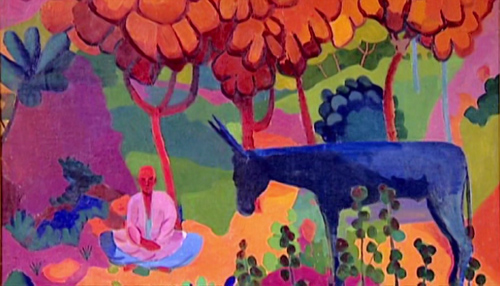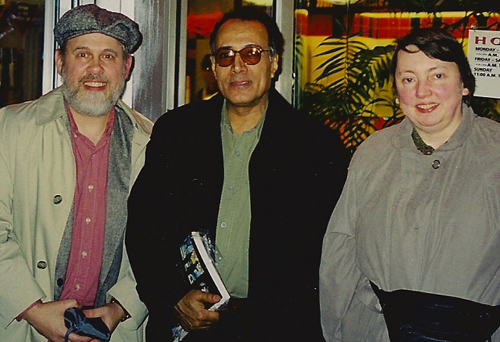A last celluloid banquet from Vancouver
Thursday | October 14, 2010 open printable version
open printable version
Detail from “Crimson Autumn” (1931) by Ural Tansykbaev (from The Desert of Forbidden Art)
Kristin here:
A Film Unfinished (Israel; dir. Yael Hersonski, 2010)
A Film Unfinished satisfies on many levels. It is based on several reels of an unfinished Nazi propaganda film labeled “The Ghetto,” discovered among an archive of thousands of cans of Nazi footage. On a simple documentary level, the scenes in the film show precious evidence of life in the Warsaw ghetto in the 1941-42 era, before most of its inhabitants were sent to death camps. As a piece of historical research on the part of the filmmakers, who found written and taped material that shed considerable light on this mysterious footage, it 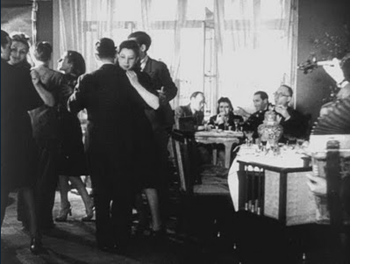 comes across as a tightly constructed detective story. For theorists of documentary who want to stress that no non-fiction films can reveal life as it is, without manipulation, A Film Unfinished provides a dramatic example.
comes across as a tightly constructed detective story. For theorists of documentary who want to stress that no non-fiction films can reveal life as it is, without manipulation, A Film Unfinished provides a dramatic example.
The samples from the silent footage shown early in A Film Unfinished show a strange combination of subject matter. Apparently candid footage of people in the street, going about their daily lives, is mixed in with scenes of well-dressed men and women in restaurants or elegant apartments. How do these incongruous scenes fit together?
The filmmakers found extensive diaries kept by one of the officials in charge of the Ghetto, as well as taped testimony given in 1961 by one of the main cameramen who recorded the footage. Passages from these, read over additional footage from the film,gradually reveal at least part of the purpose behind the footage. The Nazis apparently wanted to show that some inhabitants of the ghetto were living a normal, even luxurious life (above left). But other scenes were shot showing these same people on sidewalks. Beggars pass by them, but the actors playing the well-off Jews were instructed to ignore them. The result would 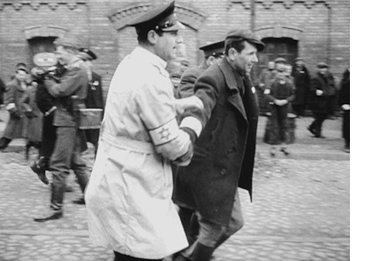 presumably have been a display of Jews not only living well but also indifferent to the fates of their less fortunate neighbors.
presumably have been a display of Jews not only living well but also indifferent to the fates of their less fortunate neighbors.
The filmmaking process frequently intrudes. Apart from the voiceover readings from witnesses to the filming, there are occasional glimpses of cameramen in the backgrounds of scenes (left). Moreover, one reel of the rediscovered film turned out to be unedited takes of several brief sequences, showing retakes of the same footage. Thus an apparently candid shot of two little boys looking into a shop window abundantly stocked with food turns out to have been staged; we even get a glimpse of one of the filmmakers leaning into the shot to direct the boys. A scene of police clearing a crowded street was done by assembling a large group of Jews and then having the police drive people away (the scene at left being part of that action). Urgency was added when the filmmakers fired shots into the air to frighten the crowd.
An added layer was given to A Film Unfinished by assembling a small group of men and women from the ghetto who witnessed many of the events. They are seen watching the film and adding comments. One remembers having seen the filming. Another worries that she will see someone she once knew among the faces on the screen. The presence of these witnesses emphasizes the fact that what we are watching in the rediscovered footage is both an elaborately staged series of events and a grim record of reality in the ghetto. A particularly grim sequence shows men with a handcart gathering corpses from the sidewalks (where helpless relatives, without any other recourse, dumped them overnight). These are taken to a mass grave, where they are stacked like firewood, covered with sheets of paper, and buried. Though the men working at this grisly task were clearly told what to do by the filmmakers, the fact remains that this gathering and disposing of bodies was a routine that went on daily in the late days of the ghetto.
A Film Unfinished would be very useful in a class on documentary cinema.
The Desert of Forbidden Art (Russian/USA/Uzbekistan; dir. Tchavdar Gorgiev and Amanda Pope, 2010)
Our interest in 1920s and 1930s Soviet avant-garde art led David and me to this film. It reveals the remarkable, unknown work of Igor Savitsky, a Russian Russian archaeologist who discovered the culture and art of the Karakalpakstan region of Uzbekistan. Applying for government funds to create the Karakalpak Museum of Arts, Savitsky initially stocked it with the jewelry, costumes, pottery, and other local cultural artifacts that were discouraged by the Soviet modernization policy.
He also discovered that there were many hidden paintings and drawings by artists whose avant-garde tendencies had gotten them into trouble with the central Soviet government in the Stalinist era. In 1966 he secretly–and very illegally–began using government money to buy up whole caches of these works. By the time of his death in 1984, he had acquired around 44,000 of them! Many are still in storage, awaiting restoration, but the galleries of this remote museum are full of extraordinary, hitherto unknown artworks.
The Desert of Forbidden Art is informative not only about the history of Savitsky and the museum, but it reveals something of the current culture of this isolated province, a culture which figures prominently in the artworks as well. Sons and daughters of the artists appear on camera, as does Marinika Babanarzorova, the museum’s current director. Naturally many beautiful artworks are on display as well.
The film touches only briefly on the fact that these artworks have been hidden away in a remote desert area which is also increasingly under the sway of Islamic extremism. A few documentary shots show the dynamiting of ancient rock-cut Buddha statues in adjacent Afghanistan in 2001. The head of the Nukus Museum was invited to appear with the film at the VIFF, but she was unable to get permission to leave the country. One is left wondering whether these artworks will need to be rescued anew.
The film is screening widely at film festivals and societies, mostly in the USA but in a few other countries as well. See its website for a schedule of upcoming showings. It also will be run in April or May, 2011 in the PBS series “Independent Lens.”
Certified Copy (France/Italy/Belgium; dir. Abbas Kiarostami, 2010)
This was the film I was most looking forward to at the festival, and it was the last–and best–one I saw. As usual, Kiarostami has come up with a novel approach to storytelling. (See David’s entry on Shirin.) After only one viewing, I’m not confident enough to say much about Certified Copy. Besides, almost anything I say about the plot will give away too much. This is a puzzle film that unfolds very slowly and very subtly.
It seems to work in ways almost opposite to those of the big puzzle film of the year, Inception. That film was almost all exposition, which we had to frantically note and try to piece together to get even a rough grasp of the plot. Certified Copy has almost no exposition–or none that we can recognize immediately or even trust when we do recognize it. I could gauge how slowly that recognition comes by the fact that the laughter at apparently incongruous behavior between the characters gradually faded. Different members of the audience realized at different moments that what had seemed incongruous maybe wasn’t after all, though it’s possible that the incongruity was just increasing right up to the end. Close to the end, only a lady two rows behind me was still laughing.
Essentially what happens is that a plot unfolds, and despite a lack of solid information, most of us probably infer from the conversations enough to assume we understand the two main characters and their relationship. Eventually their actions suggest that perhaps an entirely different plot and relationship has been unfolding all along. (This comes fairly late in the film, in maybe the last third or even quarter.) Perhaps the information we receive does not allow us to decide in this ambiguous situation, though I think people do tend to decide. I decided one way, David decided the other.
Interestingly, this mirrors in longer form the last sequence of Under the Olive Trees. There we are not told what the girl replies when the boy runs after her and proposes marriage one last time. In that case, too, I decided one way, David the other. Years ago we told Kiarostami this, and he laughed and said men tend to assume the girl accepts him, while women assume she rejected him. (I think there actually are some fairly clear clues earlier in the film that she will reject him, but explaining those would be a different entry.) That may be the case here, that men and women will reach opposite conclusions.
On the other hand, and this would require at least a second viewing, the film may remain utterly ambiguous about which plot is “real.” Or it may even stray into the territory of the inexplicable, à la Buñuel or David Lynch, where the difference parts of the story are each “true” but incompatible. M. Tsai suggests, “‘Certified Copy’ plays out a bit like a romantic comedy directed by David Lynch with its distinct two-halves connected by a thread.” (Not to be read until you’ve seen the film.)
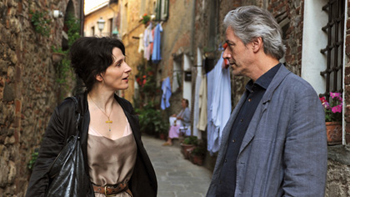 Apart from its teasing, baffling, shifting elements, Certified Copy contains two fine lead performances and, of course, some beautiful cinematography. There’s a bit of a surprise, in that Kiarostami for the most part avoids his characteristic sweeping views of landscapes. Tuscan hilltop towns would seem to be perfect for his typical shots of vehicles struggling up bending roads, but we are largely confined inside the car during the driving scene, watching the characters and not the glimpses of trees through the windows. Those yearning to see Italy must be content with stone or painted stucco walls (as at the left).
Apart from its teasing, baffling, shifting elements, Certified Copy contains two fine lead performances and, of course, some beautiful cinematography. There’s a bit of a surprise, in that Kiarostami for the most part avoids his characteristic sweeping views of landscapes. Tuscan hilltop towns would seem to be perfect for his typical shots of vehicles struggling up bending roads, but we are largely confined inside the car during the driving scene, watching the characters and not the glimpses of trees through the windows. Those yearning to see Italy must be content with stone or painted stucco walls (as at the left).
For many links to articles and reviews, see David Hudson’s helpful wrap-up on Mubi. (Again, not until you’ve seen the film.)
Sodankylä Forever (Finland; dir. Peter von Bagh, 2010)
DB here:
Do writers write books about fanatical readers? Do composers write operas about opera lovers? Sometimes, but not to the degree that cinephiles delight in making films about their passion. Case in point: Peter von Bagh’s Sodankylä Forever. The Festival screened two films devoted to Finland’s Midnight Film Festival, which not only runs movies around the clock but hosts marathon interviews with filmmakers.
It isn’t your usual red-carpet event. The town is tiny. Guests are treated to campfire cookouts and invited to play soccer. But watching old clips, catching snatches of the Johnny Guitar theme, and hearing revered directors spin their yarns is enough to bring pleasure. There are moments of drama—Zanussi and Makavejev boycott a screening of Potemkin because of its “totalitarian” ideology—but mostly the filmmakers muse in a relaxed fashion about the good, and bad, old days.
The Yearning for the First Cinema Experience treats a core cinephile topic: What was your earliest encounter with the movies? Disney films, as you might expect, play a major role, but so too does Frankenstein (which made Victor Erice realize that people kill other people) and even the MGM lion (which startled Kiarostami in his childhood). The First Experience includes more mature epiphanies, such as Bob Rafelson’s obsessive visits to Manhattan’s Thalia. If the official classics get particular attention, it’s perhaps because, as Costa-Gavras says, “Everything was done in the silent cinema.”
So cinephiles are nostalgists, sentimentalists, even narcissists. But we aren’t oblivious to history behind the screen. The Century of Cinema episode focuses on directors’ relation to World War II (a continuing fascination of von Bagh’s). An era of purges, battlefront savagery, and prison camps, created, Szabo reflects, “a generation without fathers.” Jancsó, who served time in a Finnish POW camp, pays tribute to his hosts with a recitation, in Hungarian, of the opening of the Kalevala.
After the war, however, several Western European directors recall the advent of a new era of intelligence and creative engagement. The spirit was most apparent in the Italian Neorealist films. Erice tells of sneaking a forbidden print of Rome, Open City out of customs so that Spanish cinephiles could see it. In Eastern Europe, of course, things were different, and tales of censorship and young directors’ struggle to innovate are treated as continuations of wartime crises and constraints. Alexei German sums up the status of the artist who refuses to affirm official culture: “We are not the doctors, we are the pain.” Samuel Fuller, who has already explained that being assigned to a rear-guard unit in a retreat is a death warrant, is given the epilogue. He recalls visiting the tidiest graveyard he has ever seen and turning to watch the wind rustling the grass. Was he imagining how the scene would look on film? Naturally, arch-cinephile von Bagh shows us.
DB, Abbas Kiarostami, KT. Chicago, March 1998.












